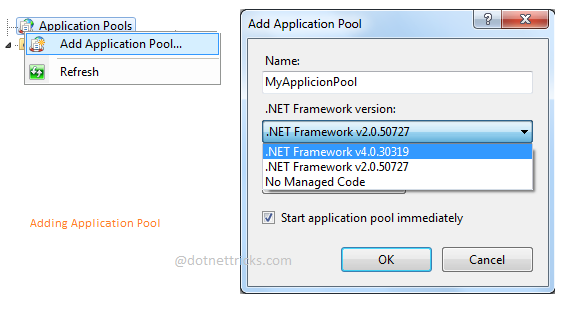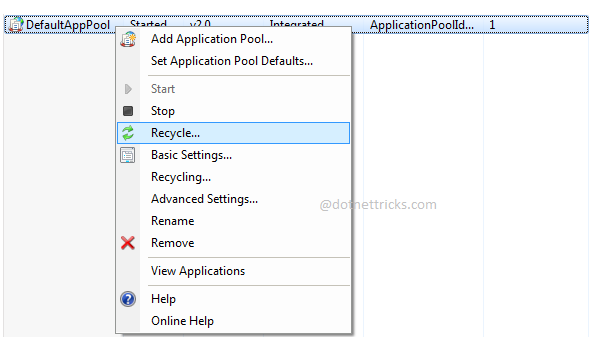Application Pool in Internet Information Service (IIS)
Application Pool in IIS: An Overview
In IIS Tutorial, an Application Pool is similar to a dedicated workspace for web applications. Consider it a secure sandbox in which each app can run without interfering with others. As a result, if one app acts badly, it won't disrupt the entire server, keeping things organized, efficient, and crash-resistant in the web hosting playground.
Application Pool in IIS
An Application Pool is a container in Internet Information Services (IIS) that groups one or more worker processes together. These worker processes are responsible for processing requests for the pool's web apps. For example you have two different website website A and website B and want to deploy on the same server, then the application pool isolate your website means website A runs on one application pool and website B runs on another application pool.

Create an Application Pool in IIS
- An Application Pool in IIS isolates & manages worker processes for your web applications.
- Simply launch IIS Manager, right-click "Application Pools," & select "Add Application Pool."
- Define a name, select a security context (such as a user account), & adjust settings such as resource limits.

Key Points About Application Pool
- Isolates and protects web apps, preventing crashes from spreading.
- Manages worker processes to ensure optimal performance and resource utilization.
- Customizable security and restrictions for increased stability and control.
- Makes app maintenance easier and improves website stability.
- Essential for a wide range of high-traffic online applications.
Configuring the Application Pool
Configuring an Application Pool in IIS entails fine-tuning settings to optimize your web app's performance, security, and use of resources. Here are a few important factors to consider:
- Identity: Select the user account that will run the pool's worker processes. This determines access privileges and application separation.
- Resource limits: Set memory, CPU, and private bytes restrictions to prevent resource exhaustion and ensure fair resource allocation among programs.
- Recycling: Manage memory use and address potential leaks or crashes by configuring how and when worker processes are recycled.
- Health Monitoring: Enable failure detection and recycling depending on specific parameters such as unsuccessful requests or high CPU utilization.
- Advanced Settings: Change the pipeline mode (traditional or integrated), startup/shutdown behavior, environment variables, and other options.
Application Pool Recycling
Recycling application pools option is available in IIS6, IIS7.x, and IIS8. This is a process for recycling the work process (w3wp.exe) and the memory used by the web application. It’s good practice to recycle the worker process periodically since it keeps the application running smoothly.
IIS 7.5 Setting for Application Pool Recycling:


How the Recycling Process Initiates?
- Pool recycling is triggered by the scheduled time, memory utilization, request count, configuration changes, or ISAPI problems.
- Overlapping recycling ensures a smooth transition: the old process completes requests while the new process handles new ones.
- Worker processes are restarted, the app is reloaded, and resources are refreshed.
- Downtime has been reduced, and the new environment is ready for incoming requests.
- The configured parameters and the app's demands determine the recycling frequency.
Advantages of using the IIS Recycling Feature
- By refreshing worker processes, it improves stability and performance.
- Reduces memory consumption by releasing resources from inactive programs.
- Increases security by isolating potential flaws in worker operations.
- Identifying and resuming malfunctioning processes simplifies troubleshooting.
- Updates applications without the need for manual intervention.
IIS RESET
In an application pool, IIS RESET does not directly kill worker processes, but instead initiates a managed restart, unloading app domains and freeing resources. It essentially refreshes the application pool without interfering with active user sessions.
Disadvantage of IIS Reset
- Short downtime during restart disrupts the user experience.
- Requests are missed while the server is reinitializing, affecting performance.
- Clears cached data, causing resource re-initialization.
- There is no selective restart, which could harm all programs.
- Failure is possible if dependent services are not ready.
Different Types of Application Pool Available in IIS 7.0 and IIS 7.5
There are two types of .NET integration modes for ASP.NET applications, that identify how IIS processes an incoming request to the sites, applications, and web services that run in that application pool.
1. Integrated Mode
- Integrated mode makes ASP.NET an integral part of IIS. Now the IIS server functionality is split into more than 40 modules that break the IIS and ASP.NET functionality into pieces.
- Modules such as StaticFileModule, BasicAuthenticationModule, FormsAuthentication, Session, Profile, and RoleManager are part of the IIS pipeline.
- FormsAuthentication, Session, Profile, and RoleManager were previously part of ASP.NET and didn't have anything to do with IIS.
2. Classic Mode
- Classic mode models the IIS 6.0 model, with ASP.NET acting as an ISAPI add-on to IIS.
- This mode is accessible for backward compatibility, however it lacks many of the new integrated mode's capabilities.
- IIS has a pipeline in Classic mode that can only be extended by building an ISAPI extension, which has a well-deserved reputation for being difficult to construct.
- ASP.NET runs as an ISAPI extension, which is only one component of the IIS pipeline.
Summary
IIS Application Pools create segregated sandboxes for web applications, improving security, performance, & stability. They control worker procedures, provide customizable settings, and make maintenance easier. Understanding identification, resource restrictions, recycling, & IIS RESET gives you the ability to improve your web experience. Application Pools are essential for dependable web hosting, from crash avoidance to rapid upgrades.





